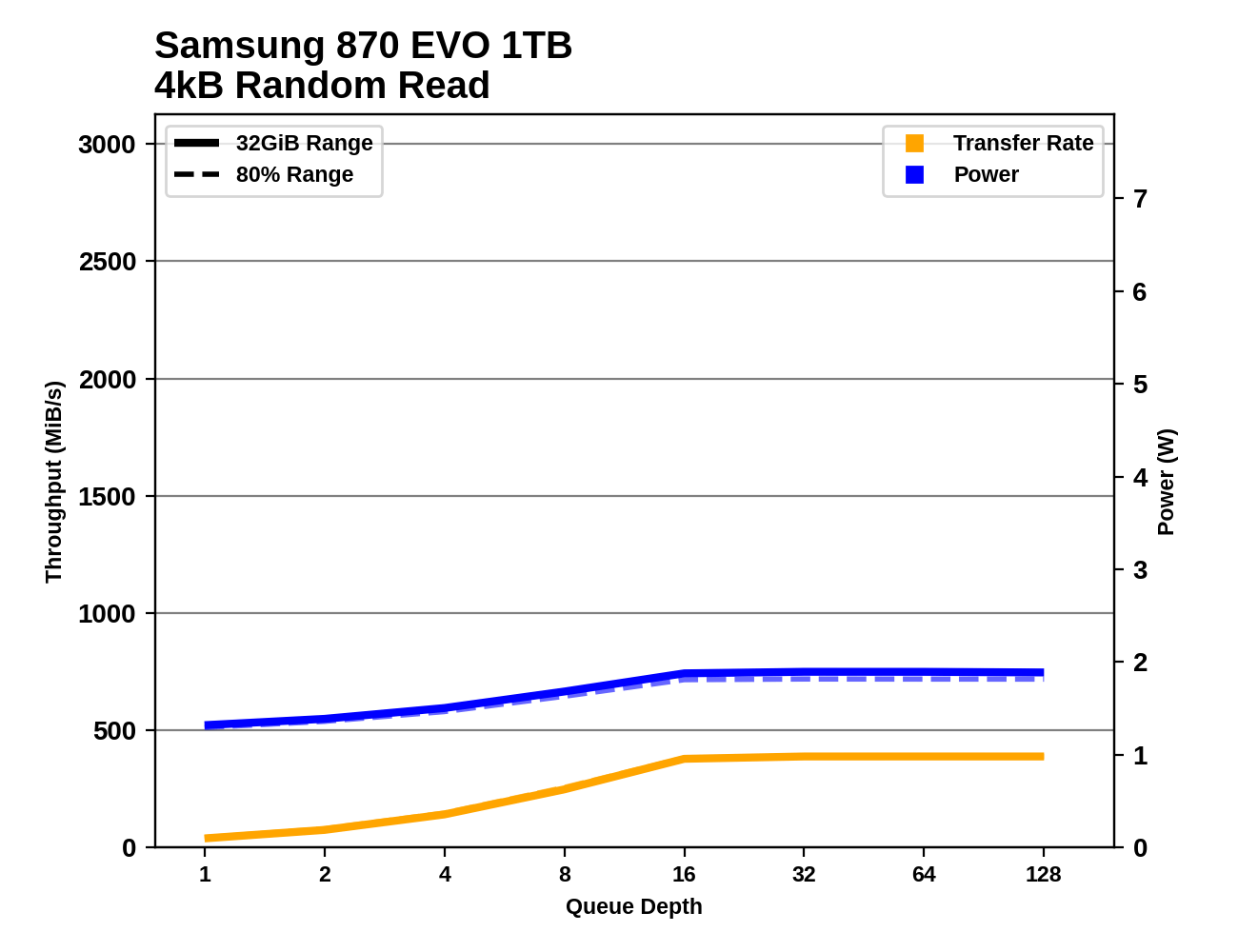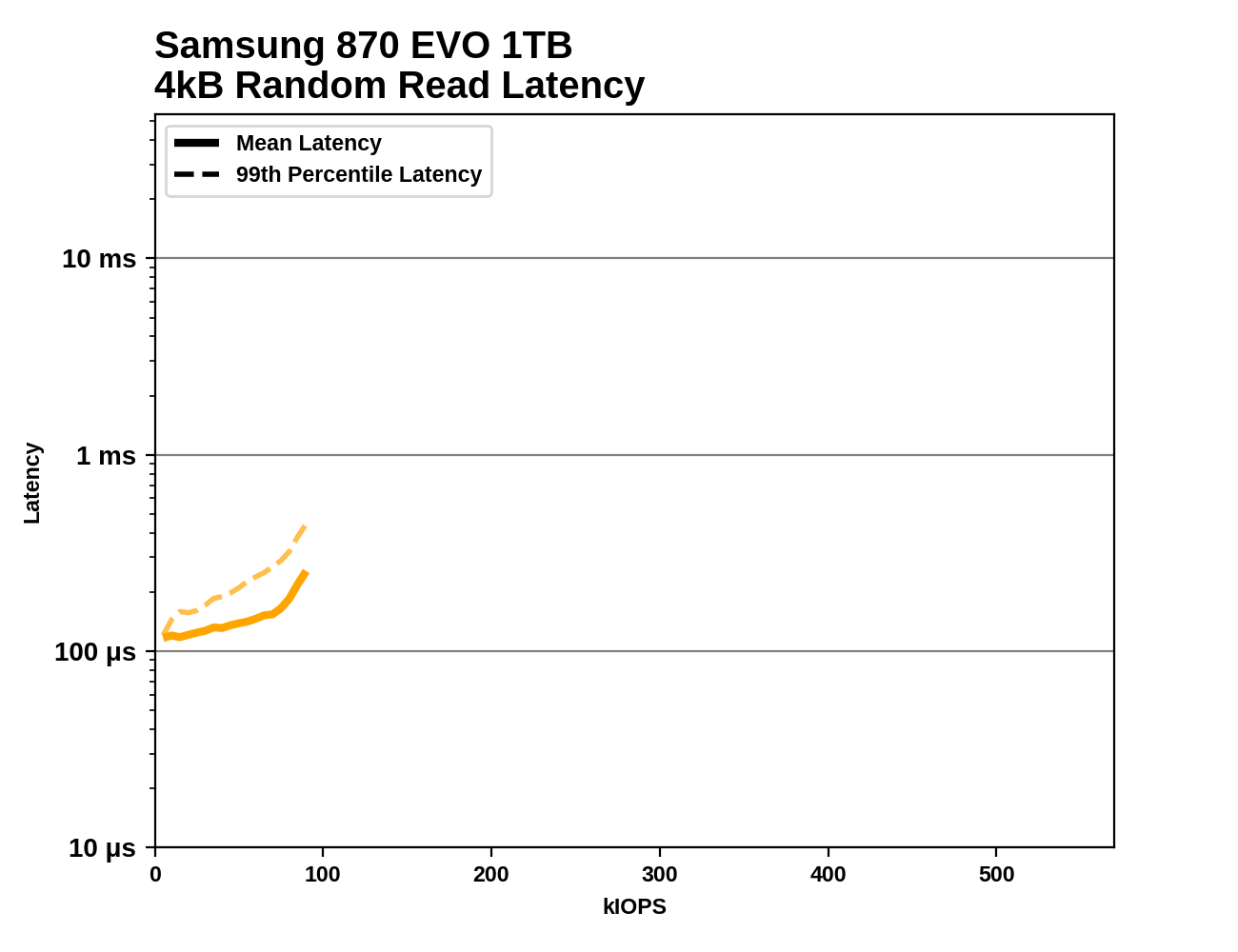The Samsung 870 EVO (1TB & 4TB) Review: Does the World Need Premium SATA SSDs?
by Billy Tallis on February 17, 2021 8:00 AM ESTBurst IO Performance
Our burst IO tests operate at queue depth 1 and perform several short data transfers interspersed with idle time. The random read and write tests consist of 32 bursts of up to 64MB each. The sequential read and write tests use eight bursts of up to 128MB each. For more details, please see the overview of our 2021 Consumer SSD Benchmark Suite.
 |
|||||||||
| Random Read | Random Write | ||||||||
| Sequential Read | Sequential Write | ||||||||
Our burst IO tests show little to no performance differences between the Samsung 870 EVO and other top SATA SSDs. The 1MB sequential transfers are already hitting the SATA throughput limits even at QD1, and the 4kB random IOs are at best marginally improved over Samsung's previous generation. Samsung's slight improvement to random read latency is enough to catch up to Micron's as shown by the Crucial MX500, but a 10% gain hardly matters when NVMe drives can double this performance.
Sustained IO Performance
Our sustained IO tests exercise a range of queue depths and transfer more data than the burst IO tests, but still have limits to keep the duration somewhat realistic. The primary scores we report are focused on the low queue depths that make up the bulk of consumer storage workloads. For more details, please see the overview of our 2021 Consumer SSD Benchmark Suite.
 |
|||||||||
| Random Read | Random Write | ||||||||
| Sequential Read | Sequential Write | ||||||||
On the longer synthetic tests that bring in some slightly higher queue depths, the improved random read performance of the 870 EVO is a bit more clear. In one sense it is impressive to see Samsung squeeze a bit more performance out of the same SATA bottleneck, but we're still talking about small incremental refinements where NVMe enables drastic improvements. Aside from random reads, the 870 EVO's performance improvements are exceedingly minute and it should be considered essentially tied with most other recent mainstream TLC SATA drives.
 |
|||||||||
| Random Read | Random Write | ||||||||
| Sequential Read | Sequential Write | ||||||||
Power consumption is one area where Samsung could theoretically offer more significant improvements despite still being constrained by the same SATA interface, but the 870 EVO doesn't really deliver any meaningful improvements there. The 4TB model is consistently a bit less efficient than the 1TB model on account of having more memory to keep powered up, but when comparing the 1TB model against its predecessor and competing drives there's nothing particularly noteworthy about the 870 EVO. SK hynix's Gold S31 has a modest efficiency advantage for random IO while Samsung is technically the most efficient of these SATA drives for sequential IO.
 |
|||||||||
| Random Read | |||||||||
| Random Write | |||||||||
| Sequential Read | |||||||||
| Sequential Write | |||||||||
The queue depth scaling behavior of the 870 EVOs is almost identical to the 860 EVOs and still quite typical for mainstream SATA drives. For random reads the 870 EVOs saturate around QD16, while for random writes QD4 suffices. On the sequential IO tests there's only a small performance gain from QD1 to QD16, and the more interesting question is how stable performance is through the rest of the sequential tests. The 1TB 870 EVO seems to run out of SLC cache a bit earlier than the 860 EVO when the sequential write test is running on an 80% full drive, but the 4TB model has plenty of cache to finish out that test at full speed.
Random Read Performance Consistency
This test illustrates how drives with higher throughput don't always offer better IO latency and Quality of Service (QoS), and that latency often gets much worse when a drive is pushed to its limits. This test is more intense than real-world consumer workloads and the results can be a bit noisy, but large differences that show up clearly on a log scale plot are meaningful. For more details, please see the overview of our 2021 Consumer SSD Benchmark Suite.
 |
|||||||||
Consistent with most of our other read performance tests, the Samsung 870 EVO shows slightly better average and 99th percentile random read latencies than most of its SATA competition. Even some of the entry-level NVMe drives that can deliver higher random read throughput than is possible for the 870 EVO still have clearly higher latency across most or all of the throughput range that the 870 EVO can cover. A QLC-based or DRAMless TLC NVMe SSD can potentially offer far higher throughput than any SATA SSD, but clearly beating the 870 EVO on both throughput and latency requires stepping up to a more mainstream NVMe design with DRAM and TLC NAND.










136 Comments
View All Comments
Glaurung - Wednesday, February 17, 2021 - link
The main barrier for the formal death of SATA are hundreds of millions of perfectly usable older systems that don't support NVME or have limited NVME slots.Qasar - Wednesday, February 17, 2021 - link
" Main barrier for the formal death of SATA is still cost as NVMe still carries a slight premium over SATA and consumer systems have limited PCIe connectivity. "i think you might be also forgetting the aspect of the space requirements of the nvme connector as well.
Lord of the Bored - Wednesday, February 17, 2021 - link
I've always thought SATA was a mistake.Removing the ability to chain multiple drives made for an ugly cabling situation, and the connectors are flimsy as hell. The new power connector in particular served no purpose whatsoever aside from annoyance.
If it had used more robust connectors and allowed chaining drives, it would've been fantastic. But that would've been to much like the right decision for them to entertain it.
Glaurung - Wednesday, February 17, 2021 - link
SATA on the desktop and in NAS boxes is still very much alive, TYVM.Sata SSDs will continue to be made and sold as long as there are older computers in use that have a SATA bay in them. My main computer only has 1 NVME slot, but it also has a SATA bay. WIthout that SATA bay I'd have to have all my files crammed onto on a single SSD.
Kamen Rider Blade - Wednesday, February 17, 2021 - link
The technology to update SATA is there, it just takes a bit of will power from the SATA group to borrow the SAS speeds and bring it to the consumers.The SATA connector is far better suited for "Hot Swap" and M.2 was never designed for "Hot Swap" capabilities.
powerarmour - Wednesday, February 17, 2021 - link
No, we'll require SATA for bulk storage for a good few years yet.How many M.2 only NAS systems are there?
CaedenV - Wednesday, February 17, 2021 - link
SATA is still perfectly fine for old spinning rust drives. Sure the burst performance could be better with a faster connection... but how often is that needed? For sustained data transfers SATA3 is still faster than any spinning drives on the market that cap out at 150-200MBps on a good day.watzupken - Wednesday, February 17, 2021 - link
I don't think SATA is going to go away anytime soon. While it is not as fast as a good NVME SSD, it makes up for it by offering a good price to capacity ratio. It just like why mechanical drive still exists today. Most NVME SSDs are affordable up to around 1TB, and at higher capacity, the prices goes up significantly. Also one is usually limited to 2 or 3 NVME slots due to limitation of number of PCI-E lanes. Thus, having the SATA ports to supplement additional storage is unlikely to go away, at least from a desktop perspective.sonny73n - Thursday, February 18, 2021 - link
"..,Most NVME SSDs are affordable up to around 1TB, and at higher capacity, the prices goes up significantly."Please stop spouting BS.
ADATA SX8200 Pro 2TB M.2 $239
Samsung 870 EVO 2TB SATA $249
Both is on Amazon right now.
Oxford Guy - Friday, February 19, 2021 - link
2TB on black Friday for an ADATA over a year ago. $250 isn't impressive.